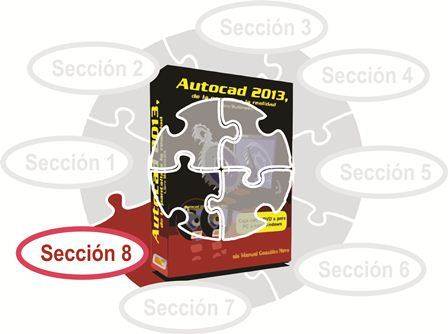3D Drawing with AutoCAD - Section 8

37.4.6 PulsarTirar
We can say that Pulsartirar is a variant of Extrusion and Difference in a single command, according to the sense in which it is applied. Pulsartirar allows to create an extrusion or a difference on a complete face of a solid, or on a closed area that is drawn or stamped on a face, as long as the edges and vertices of that closed area are coplanar.
If we pull the area or face, then the result will be a new extruded solid attached to the original solid. If, instead, we click on the area or face, then it can be understood as a difference edition of the solid and the result will be a notch in it.
On the other hand, as you will recall, drawing 2D objects on solid faces (to create closed areas on them) is very simple if you use dynamic SCPs. Then, using the Pulsarrite command only involves detecting those areas or applying them over the entire area of the solid.
37.4.7 Sheath
This command creates a wall in the solid of the specified thickness. We can create it on all faces giving a closed but hollow solid, or we can eliminate specific faces before concluding the command. Positive thickness values create the sheath into the solid, negative values towards the outside. This command can not be applied on other sleeves.
37.5 Chamfer and Junction 3D
Surely remember well the operation of the Chamfer and Splice commands on 2D objects, in the first case cut out two lines that formed vertex and joined them with another line. In the case of Empalme, he linked them with a bow. These 3D solids commands allow you to chamfer or round the edges of the XNUMXD solids. To do this, we must select the edges of the solid that will be modified. In the case of Chamfer, we must also give a distance for the cut or bevel that will form and in the case of Splice a value of radius. Otherwise, the application of both commands is very similar and extremely simple.
37.6 Edition by gripping
In chapter 19 we define and review the editing of objects through their grips. In that place we mentioned that the grips appear in the key points of the objects. In the case of 3D solids such key points are determined by the method we have used to create the solid. That is, if it is about objects from profiles, primitives or composite solids. In turn, the use of the grips is the same as the ones that appear in 2D objects: some grips only allow us to move the object, to others we can drag them with the mouse, so that the shape of the object changes.
In the case of the primitives, the grips are in those points that, when constructing them, require a value. For example, in the case of a cone its center, the radius of the base, the height and the upper radius. In the case of a sphere two grips appear, one in the center point and another one that allows us to modify the value of the radius and so on for each primitive.
The solids created from profiles using Revolution, Sweep, Extrusion and Solevation have grips in the profiles. By dragging the grip, and thus modifying the shape of the profile, extrusion, sweep, etc. will be updated by also modifying the entire solid.
Finally, the composite solids have a single grip with which it is only possible to move it. In such cases we must activate the history of the compound solid as we will see in a later section, in this same chapter.
So let's take a look at the grips on the different types of solids.

